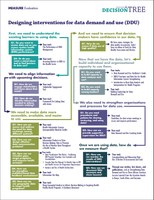A Decision Tree: Making decisions on data demand and use
 High-quality, timely, and accessible data are essential for the effective planning and management of healthcare services. Increasing investments in health information systems, coupled with advancements in technology for data collection, analysis, and visualization, means that we have vast amounts of data available at our fingertips.
High-quality, timely, and accessible data are essential for the effective planning and management of healthcare services. Increasing investments in health information systems, coupled with advancements in technology for data collection, analysis, and visualization, means that we have vast amounts of data available at our fingertips.
These innovations offer exciting opportunities to gain insight from data that could inform better targeting of health interventions for vulnerable populations, improved service delivery, and better health outcomes. But, along with the opportunities comes the problem of managing the volume of data, providing it in usable formats to stakeholders, and putting it to work to inform effective and efficient program and policy decisions.
To take advantage of this data revolution, we must guarantee that the work environment values data-driven approaches and incentivizes the use of data. Though most agree that change management is essential to transform team attitudes and behaviors towards data, it can be daunting to know where to start when planning, implementing, and evaluating data use interventions.
Recently, the MEASURE Evaluation project, funded by the United States Agency for International Development (USAID), developed and published a Decision Tree for Designing Interventions for Data Demand and Use to help guide national government ministries, donors, and implementers in designing interventions to improve data use.
This decision tree provides insights for strategies to consider when strengthening data-driven action and decision making. The tool poses questions on multiple considerations for data use interventions, such as:
- What are the existing barriers to data use?
- How should information needs align with upcoming decisions?
- How does one ensure that data are accessible, available, and easy to use?
- How do we assure data quality?
- What are some ways to build individual and organizational capacity for data use?
- How can we strengthen an organizational culture and data use practice?
- How do we monitor and document the results of data use interventions?
For each of these aspects, the decision tree then guides users through publicly available tools, guidance documents, and training toolkits. A high-level description of each tool, its intended users, investment required, and intended result is provided so users can decide on its appropriateness and relevance for their need. The tools in this guide have been implemented across multiple contexts and health system levels and can be adapted for project or program needs.
We hope that this decision tree will help those looking for practical resources to design and implement data use interventions. For more information on MEASURE Evaluation’s work to strengthen capacity to gather, interpret, and use data to improve health, please visit our website at: https://www.measureevaluation.org/our-work/data-demand-and-use.
For more information, read about MEASURE Evaluation’s work in data demand and use.












